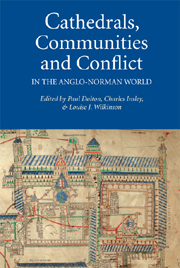Book contents
- Frontmatter
- Contents
- List of Illustrations
- List of Contributors
- Preface
- List of Abbreviations
- Introduction
- 1 The Dangers of Invention: The Sack of Canterbury, 1011, and the ‘theft’ of Dunstan's Relics
- 2 Remembering Communities Past: Exeter Cathedral in the Eleventh Century
- 3 Communities, Conflict and Episcopal Policy in the Diocese of Lichfield, 1050–1150
- 4 The Acta archiepiscoporum Rotomagensium and Urban Ecclesiastical Rivalry in Eleventh-Century Rouen
- 5 Cathedrals and the Cult of Saints in Eleventh-and twelfth-Century Wales
- 6 A Bishop and His Conflicts: Philip of Bayeux (1142–63)
- 7 Ecclesiastical Responses to War in king Stephen's Reign: The Communities of Selby Abbey, Pontefract Priory and York Cathedral
- 8 Secular Cathedrals and the Anglo-Norman Aristocracy
- 9 The Lives of Thomas Becket and the Church of Canterbury
- 10 Caught in the Cross-Fire: Patronage and Institutional Politics in Late twelfth-Century Canterbury
- 11 Crown, Cathedral and Conflict: King John and Canterbury
- 12 The English Monasteries and their French Possessions
- Index of People and Places
- Other Volumes in Studies in the History of Medieval Religion
7 - Ecclesiastical Responses to War in king Stephen's Reign: The Communities of Selby Abbey, Pontefract Priory and York Cathedral
Published online by Cambridge University Press: 12 September 2012
- Frontmatter
- Contents
- List of Illustrations
- List of Contributors
- Preface
- List of Abbreviations
- Introduction
- 1 The Dangers of Invention: The Sack of Canterbury, 1011, and the ‘theft’ of Dunstan's Relics
- 2 Remembering Communities Past: Exeter Cathedral in the Eleventh Century
- 3 Communities, Conflict and Episcopal Policy in the Diocese of Lichfield, 1050–1150
- 4 The Acta archiepiscoporum Rotomagensium and Urban Ecclesiastical Rivalry in Eleventh-Century Rouen
- 5 Cathedrals and the Cult of Saints in Eleventh-and twelfth-Century Wales
- 6 A Bishop and His Conflicts: Philip of Bayeux (1142–63)
- 7 Ecclesiastical Responses to War in king Stephen's Reign: The Communities of Selby Abbey, Pontefract Priory and York Cathedral
- 8 Secular Cathedrals and the Anglo-Norman Aristocracy
- 9 The Lives of Thomas Becket and the Church of Canterbury
- 10 Caught in the Cross-Fire: Patronage and Institutional Politics in Late twelfth-Century Canterbury
- 11 Crown, Cathedral and Conflict: King John and Canterbury
- 12 The English Monasteries and their French Possessions
- Index of People and Places
- Other Volumes in Studies in the History of Medieval Religion
Summary
It is well known that religious communities in England suffered as well as flourished during the reign of King Stephen (1135–54), a period dominated by a protracted civil war fought for control of the crown. The extent of this suffering and efflorescence has been studied extensively. Less attention has been paid to the methods by which religious communities sought to deal with the threats and violence that faced them, to protect and promote their interests and secure their peace and safety, and to reconcile themselves with their oppressors. This chapter will help to illuminate these themes as they relate to two monasteries and one cathedral community in Yorkshire. The monasteries are the Benedictine abbey of St Mary and St Germanus, Selby, the foundation of which in 1069–70 owed much to the support of William the Conqueror, and the Cluniac priory of St John the Evangelist, Pontefract, established during the 1090s by Robert I de Lacy, lord of Pontefract. The cathedral is that of St Peter's, york, whose hospital (also named St Peter's) in york and important estate at nearby Sherburn will be particular centres of attention. The chapter will begin by discussing some of the damage suffered by these communities, and the political and military context in which it occurred. It will then explore some of the practical and spiritual ways in which the communities sought to respond to the difficulties, dangers and opportunities that faced them. Its conclusions have a wider bearing on understanding the processes that brought the civil war to an end.
- Type
- Chapter
- Information
- Cathedrals, Communities and Conflict in the Anglo-Norman World , pp. 131 - 150Publisher: Boydell & BrewerPrint publication year: 2011

